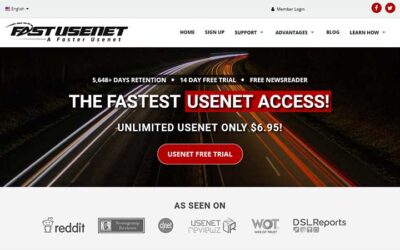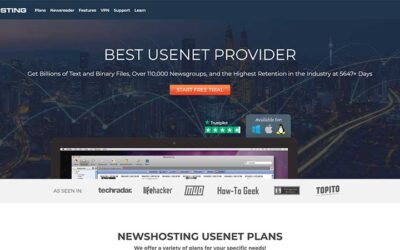Usenet has been a cornerstone of online communication and file sharing for decades, evolving from a purely text-based system to a massive repository of binary content. However, as Usenet grew, so did the challenges of efficiently finding and downloading content. This is where NZB files revolutionized the experience, offering a streamlined and efficient way to retrieve large binary files without the need for manually navigating newsgroups. This guide covers everything you need to know about NZB files, including their history, technical functionality, and their role in simplifying Usenet access.
Contents
What Is an NZB File?
An NZB file is an XML-based document that acts as an index for downloading specific files from Usenet. Unlike traditional browsing methods that require users to download and sift through headers from multiple newsgroups, NZB files point directly to the needed file segments, making downloads significantly faster and more efficient.
Usenet content is uploaded in segments, each assigned a unique Message-ID. An NZB file contains these Message-IDs, allowing newsreader software to download all relevant pieces automatically and reconstruct the original file. Essentially, an NZB acts as a roadmap that guides a newsreader to the correct data without unnecessary overhead.
The History of NZB Files
Before NZB files, downloading binaries from Usenet was a tedious process. Users had to manually browse newsgroups, retrieve headers for thousands (or even millions) of posts, and then piece together the individual parts of a file. This process was not only time-consuming but also bandwidth-intensive.
NZB files were introduced by Newzbin, one of the first Usenet indexing websites, to solve this inefficiency. Newzbin developed the NZB format as a structured way to compile Message-IDs into a single file. This format allowed newsreaders to automatically fetch all parts of a file, eliminating the need for users to download and scan vast amounts of headers.
Since their creation, NZB files have become the industry standard for downloading Usenet content, with countless NZB indexers, Usenet providers, and newsreader applications supporting them.
How NZB Files Work
NZB files function as a set of instructions for newsreaders, guiding them to the correct files across Usenet. Here’s a step-by-step breakdown of how NZB files are used:
Indexing Content:
- When files are posted to Usenet, they are divided into small segments due to size limitations in newsgroup postings.
- These segments are encoded (often using yEnc or UUencode) and assigned unique Message-IDs.
- An NZB indexer (a website that catalogs Usenet content) scans newsgroups, collects Message-IDs, and organizes them into an NZB file.
Downloading an NZB File:
- Users browse an NZB indexer to find the content they want.
- Once they select a file, they download its corresponding NZB file, which contains all necessary Message-IDs.
Using a Newsreader:
- The NZB file is loaded into an NZB-compatible newsreader (such as SABnzbd, NZBGet, or Newsbin).
- The newsreader connects to a Usenet provider, retrieves the segments using the Message-IDs, and reassembles the complete file.
- Many modern newsreaders automatically handle parity checking (using PAR2 files) and decompression (such as extracting RAR files), ensuring a smooth experience.
How NZB Files Simplify Usenet Usage
NZB files have transformed the way people use Usenet, making the process significantly easier in several ways:
1. Eliminates the Need for Downloading Headers
Traditionally, users had to retrieve entire headers from a newsgroup to locate a file, a process that could take hours. NZB files bypass this by directly linking to the necessary segments.
2. Saves Bandwidth and Time
Without NZB files, users would have to download large amounts of header data. By using NZBs, only the required data is fetched, reducing bandwidth usage and speeding up downloads.
3. Automates File Assembly
Since files are posted to Usenet in multiple parts, manually assembling them would be tedious. NZB-compatible newsreaders handle the entire process, automatically fetching and reassembling all parts.
4. Enhances Searchability with NZB Indexers
Indexers act like search engines for Usenet, allowing users to quickly locate and download NZB files instead of manually searching newsgroups.
5. Reduces Complexity for New Users
NZB files make Usenet more user-friendly, allowing even beginners to quickly find and download content without understanding the intricate details of Usenet newsgroup structures.
How to Use NZB Files Step-by-Step
If you’re new to using NZB files, follow these steps to get started:
Step 1: Choose a Usenet Provider
To download content from Usenet, you need a Usenet subscription. Popular providers include:
Each provider has different retention rates, speeds, and pricing structures.
Step 2: Find an NZB Indexer
NZB indexers are websites that compile and organize NZB files. Some popular NZB indexers include:
- NZBGeek
- NZBPlanet
- Binsearch (a free search engine)
Some indexers require membership or a donation to access full search functionality.
Step 3: Download an NZB File
Once you find the file you want, download its corresponding NZB file to your computer.
Step 4: Open the NZB in a Newsreader
Install and configure an NZB-compatible newsreader such as:
- SABnzbd (browser-based, beginner-friendly)
- NZBGet (lightweight, great for automation)
- Newsbin Pro (powerful, feature-rich)
Import the NZB file, and the software will start downloading the content.
Step 5: Let the Newsreader Handle the Rest
Modern newsreaders will:
- Download all necessary file segments
- Verify integrity using PAR2 files
- Decompress archives if needed
- Delete temporary files after completion
After the process finishes, your file is ready to use.
NZB vs. Torrent: What’s the Difference?
While NZB files and torrents both simplify downloading, they operate very differently:
| Feature | NZB Files (Usenet) | Torrents (P2P) |
|---|---|---|
| Source | Usenet servers | Peer-to-peer (P2P) |
| Download Speed | Consistently fast (server-based) | Varies (depends on seeders) |
| Privacy | More private (no sharing) | Less private (uploads required) |
| Reliability | High (files remain available for years) | Unreliable (depends on seeders) |
| Setup Complexity | Requires paid Usenet provider | Usually free, but requires seeders |
NZB files are superior for speed, privacy, and reliability, while torrents are more accessible to casual users.
Conclusion: The Power of NZB Files
NZB files have completely transformed the Usenet experience, making it faster, more efficient, and user-friendly. By leveraging NZB files, users can skip manual searching, avoid unnecessary downloads, and automate file retrieval with ease.
For those serious about Usenet, learning to use NZB files is essential. Whether you’re downloading large binaries or simply trying to make the most of your Usenet subscription, NZB files streamline the process and unlock the full potential of Usenet.
Key Takeaways
✔ NZB files simplify Usenet downloads by pointing directly to file segments.
✔ They eliminate the need to download headers, saving bandwidth and time.
✔ Newsreaders handle the entire process, from downloading to file assembly.
✔ Using NZB indexers makes searching for content much easier.
✔ Compared to torrents, NZBs offer better speed, privacy, and reliability.
If you’re looking to optimize your Usenet experience, NZB files are the best way to get started.




